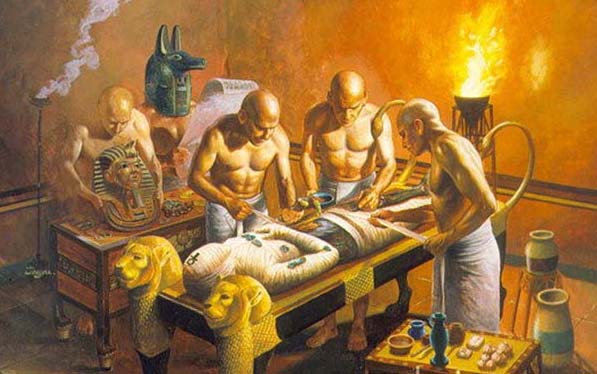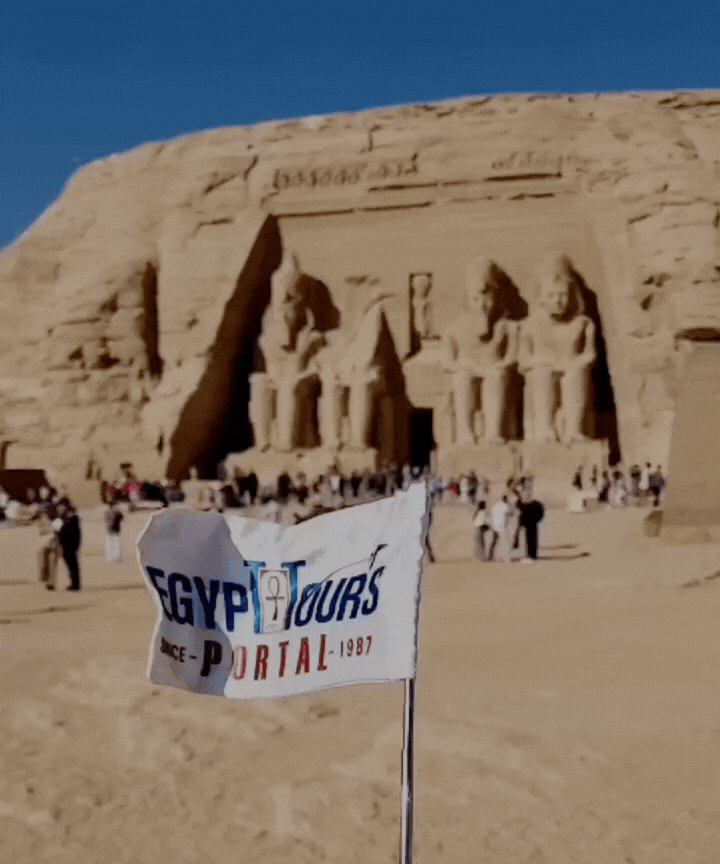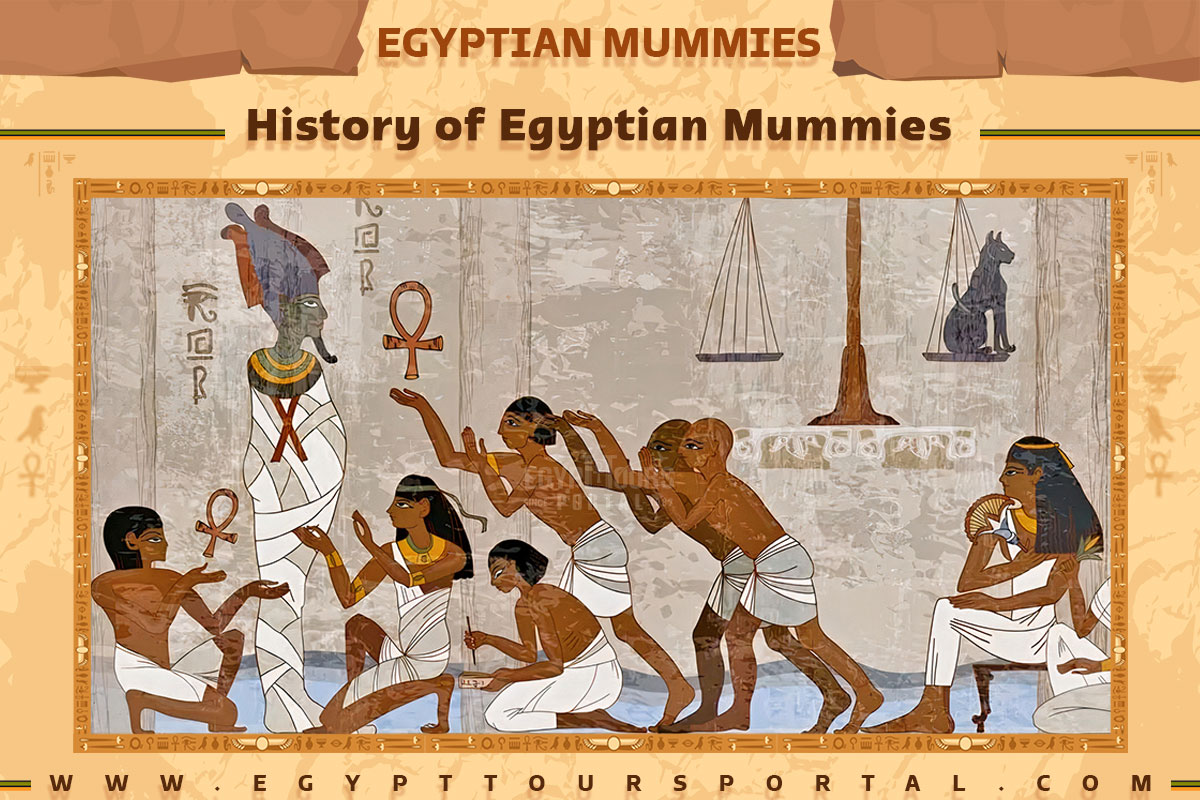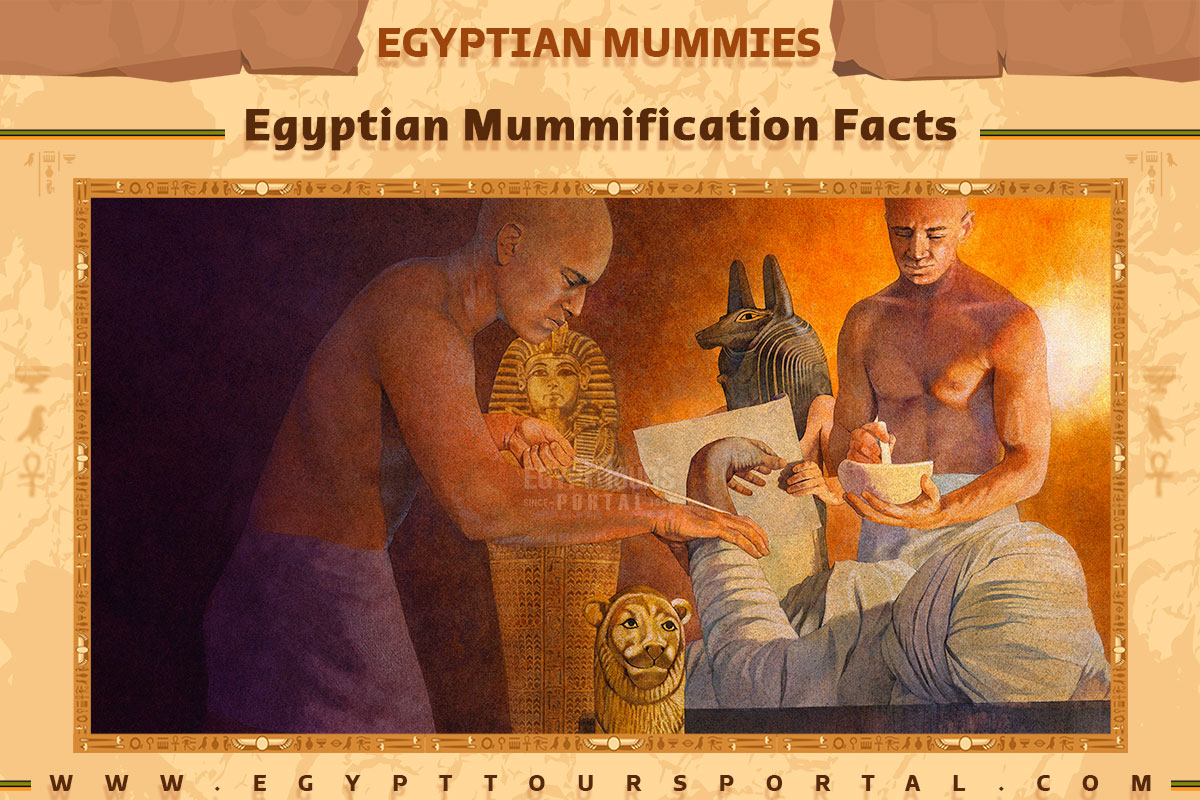- Local Time: 08:29 PM
- Weather: 26 ℃ / 79 ℉
The Wait Is Over – The GRAND EGYPTIAN MUSEUM Is Opening Its Doors! Be among the first to explore Egypt’s greatest treasure.
Ancient Egyptian Mummification spanned from 2600 BCE to the Roman era, Egyptians refined burial from simple sand desiccation into a 70-day ritual run by priest-embalmers. Organs were removed, the corpse packed in natron, then wrapped in resin-soaked linen and sealed in coffins inscribed with spells to reunite the ka and ba before Osiris. Cost determined quality, yet kings, commoners, and even sacred animals were all mummified. Finds like Tutankhamun’s gold mask and canopic jars reveal superb artistry. Classical writers and tomb texts record the process; modern scans expose diet and disease. Tales of “mummy curses” echo the Egyptians’ reverence for preserving the body to secure eternal life


The Ancient Egyptians were keen believers in the concept of the afterlife and the resurrection of both the body and soul. That set of beliefs originated from their observations across their daily life, such as the sun falling across the western horizon each evening and then being reborn once again the next morning in the east. The ancient Egyptian soil would sprout new life from the planted grain. The moon would change its shape each year.
The ancient Egyptians believed in a sense of balance, law & order, and the promise of a new life after death. They utilized many scientific tools and procedures in order to preserve the dead, which is called the mummification process, which was performed by highly skilled specialists. This honorable tradition was a rite of passage for all the ancient Egyptians to seek to enter the afterlife.
This article endeavors to provide a comprehensive exploration of Ancient Egyptian mummification, primarily focusing on ancient Egyptian practices while also touching on broader aspects of mummification across cultures. By delving into various dimensions of this intriguing funerary tradition, our aim is to enlighten readers about the diversity of individuals who underwent mummification, the historical backdrop that nurtured its development, and the profound reasons that compelled ancient Egyptians to preserve their deceased.
Through a meticulous examination of the intricate mummification process, we seek to unveil the techniques employed while dispelling common misconceptions. Furthermore, our goal extends to conveying fascinating facts about ancient Egyptian mummification that might surprise and captivate our audience.
Curious about history's enigmas? Immerse yourself in the captivating List of Famous Ancient Egyptian mummies. Unveil a curated list of these enthralling relics, each holding secrets of a rich civilization. Embark on a journey of discovery and trace the steps of the past through these remarkable archaeological treasures.

The practice of mummification was highly widespread starting from the early days of ancient Egypt. The key behind the mummies occurred in prehistoric times when the air and dry sand, with the lack of rainfall, preserved many bodies in shallow pits. In the 4th and 5th dynasties, about 2600 BC, ancient Egypt began to mummify their bodies according to their religious teachings.
The art of mummification was completely perfected during the Third Intermediate period (1070 – 712 BC). Across the next 2000 years, the practice of mummification continued and developed all the way to the Roman Period (30 BC – 364 BC). With each period, the mummification quality changed according to the price that was paid.
Highly sophisticated and preserved mummies date from the 18th and 20th dynasties during the New Kingdom of Egypt (1550 – 1070 BC). In the late period around 450 BC, the great historian Herodotus documented the entire mummification process. The Mummification process faded away in the 4th century when Rome ruled Egypt was a Christian nation that ruled out the mummification process. Many scholars and historians believe the mummification process at a lost art, but many elements of the process can be found in the way current people honor their loved ones.

Before the mummification process evolved to its finest form, the corpse was put in a pit in the desert in a fatal sleeping position with all its precious personal items. All the water would be absorbed from the body, thus preserving it. The body was wrapped in animal skins inside a wooden or pottery coffin, lined with many mud bricks, and covered entirely so that the preservation process to be more intact. The internal organs were removed, dried, and put in jars to improve the mummification process.
The process was performed by skilled priests who extracted the brain from the nostrils with an iron hook, then the flank was opened the content of the abdomen was totally removed. The cavity is cleaned and filled with cassia and myrrh plus other aromatic substances. The body is sewn up and covered in natron entirely for 70 whole days; afterwards, the body is washed and put in linen bags for 35 days to draw all the moisture across all the tissues. All the removed organs, such as lungs, liver, stomach, and intestines, were then put in Canopic jars with dry natron; the heart was left in the body as the core of intelligence.
The body was then filled with lichen, sawdust, cloth scraps, and Nile mud to make the body flexible. The Ancient Egyptians would then replace the eyes with linen pads and small cooking onions. In the Middle Kingdom, it became a standard to place a mask over the face of the mummy. Prayers from the Book of the Dead were added to the mummy to make his transition to the afterlife as safe and successful as possible.
Ancient Egyptian Mummies are the embodiment of ancient Egyptian beliefs. Here is a list of ancient Egyptian mummies and their facts.
Read MoreStep 1: Insert a hook through a nostril hole to extract a portion of the brain.
Step 2: Make an incision on the body's left side near the abdomen.
Step 3: Remove all the internal organs.
Step 4: Allow the internal organs to dry.
Step 5: Store the lungs, stomach, intestines, and liver in canopic jars.
Step 6: Return the heart to its original position within the body.
Step 7: Cleanse the interior of the body with a mixture of wine, herbs, and spices.
Step 8: Cover the deceased body with natron (salt) for exactly 70 days.
Step 9: After 40 days, fill the body with linen or sand to restore a lifelike form.
Step 10: At the conclusion of the 70-day period, enshroud the body in bandages from head to toe.
Step 11: Place the wrapped body within an ancient Egyptian sarcophagus, a decorated ancient Egyptian coffin.
Final Step: If the individual held the status of a Pharaoh, they would be interred in an exclusive burial chamber decorated with spells from ancient Egyptian texts like the Book of the Dead, along with abundant treasures that would assist them in their journey to the afterlife.

The ancient Egyptians believed in life after death, and when a person dies, their spiritual essence still lives, and in order for the soul to survive, the body has to remain intact. They believed that the spirit is divided into three parts: the Ka, Ba, and Akh. The ka was considered the "Double" of the person, who would stay in the tomb, and offerings and objects were presented. The Ba, or "Soul" is free to fly out of the tomb and return at any time. The Akh, or the "Spirit", would travel through the Underworld with Anubis to attend the Final Judgment with Osiris and entrance to the Afterlife.
The process of preserving the body and turning them into mummies was described in detail in the Pyramid Texts, accompanied by the story of Osiris’s death where the universe fell into utter chaos, and the tears of the gods transformed into materials such as resins, honey, and incense used for the mummification process.
Discover how ancient Egyptians viewed death and how it changed their face of their entire civilization
Read More
The Pharaohs of Egypt, after death, were mummified and buried in a highly elaborate tomb to earn their rightful place in the heavens with the ancient Egyptian deities. All members of royal high officials, royalties, society elites, and nobility received the same service and treatment, plus all the common people who could offer them, which was considered to be expensive. Many ancient Egyptians, for religious reasons, chose to mummify ancient Egyptian animals that were considered to be sacred, such as bulls, cats, crocodiles, snakes, birds, and more.

Facts 1: The practice of Ancient Egyptian mummification started accidentally, with bodies preserved in dry sand, but intentional mummification began around 2600 BCE during the Fourth and Fifth Dynasties. The practice evolved over more than 2,000 years, with varying levels of quality based on payment. The best-preserved mummies are from the New Kingdom's Eighteenth through Twentieth Dynasties (ca. 1570–1075 BCE), including renowned pharaohs like Tutankhamun. The ritual of mummification was analyzed by early historians like Herodotus, who documented it during his visit to Egypt around 450 BCE.
Fact 2: The practice of Ancient Egyptian mummification was very common, and not limited to only the rich or elite. While wealthier individuals underwent an elaborate and more expensive mummification process carried out by professional embalmers, regular Egyptians had more budget-friendly options. Even the poorest could opt for a simple burial where the deceased was wrapped in linen and accompanied by the necessary spells for their journey to the afterlife, as seen across all the Ancient Egyptian coffins discovered all over Upper and Lower Egypt.
Fact 3: In the extraordinary Egyptian mummification process, all the organs like the lungs, liver, stomach, and intestines were carefully removed to prevent decay. These organs were deeply cleaned, dried, and placed in special jars that were then buried alongside the body. The heart, believed to hold a person's emotions and personality, was left in place, as it played a pivotal role in the afterlife judgment.
Fact 4: The brain, whose function was not well understood, was discarded. Embalmers used a hook through the nose to extract bits of the brain, then the cranial cavity was rinsed. The body was in natron for over 70 days. The body was then wrapped meticulously in resin-coated linen strips, often around 4,000 square feet for the most elaborate mummies, across 40 days.
Pharaohs might have been wrapped in linen that previously adorned statues of gods, while common people used strips from household linens. The Ancient Egyptian sarcophagi of the deceased were made of a number of materials, like wood, stone, or even gold, which featured some of the most enchanting art that was mostly made of spells from the Book of the Dead and titles of the deceased with information about his or her life and achievements.
Fact 5: Animal mummies were also highly common, ranging from sacred animals to beloved pets, reflecting different religious and societal practices. It is worth nothing. Animals were worshipped as gods, while others were raised for sacrificial purposes, like Cats, ibises, and Cows, plus were buried alongside their owners.
Fact 6: The notion of a "Mummy's Curse" was not a modern invention but had roots in ancient Egyptian religion or beliefs. Tomb inscriptions warned of potential consequences for tomb robbers, invoking the wrath of gods, and even haunting by ghosts. This belief reflected a fear of retribution from the spiritual realm rather than a fear of the mummies themselves.
In conclusion, ancient Egyptian mummification is a profound testament to their intricate beliefs and practices. It offers a window into their spiritual journey to the afterlife, showcasing remarkable craftsmanship and cultural insights. For a firsthand experience of Egypt's wonders, Egypt Tours Portal provides exceptional Egypt tour packages from UK and Nile River cruises.
With expert guides, comfortable accommodations, and seamless transportation, you can immerse yourself in Egypt's captivating history. Choose Egypt Tours Portal for an unforgettable journey into the mysteries of ancient Egypt.
Explore the wonders of ancient Egypt with Egypt Tours Portal. Delve into the rich history of mummification and beyond, guided by passionate experts. Their comprehensive services ensure a seamless adventure, letting you uncover the secrets of Egypt's past while enjoying top-notch comforts and insights.
Private 4 Days Cairo Tour Packages for British Travelers 4 days Cairo Egypt Tour pac...
Tour Location: Cairo – Giza...
5 Days Cairo and Alexandria Tour Package For British Travelers 5 days Cairo and Alex...
Tour Location: Cairo/Giza/Alexandria...
6 Days Cairo, Luxor & Aswan Tour Package For British Travelers 6 days Cairo, Lux...
Tour Location: Cairo/Giza/Aswan/Luxor...
Amazing 7 Days Cairo and Hurghada Holiday for British Travelers 7 Days Cairo & H...
Tour Location: Cairo – Giza – Hurgh...
Mummification in ancient Egypt was deeply intertwined with their belief in the afterlife. The Egyptians believed that death was not the end but rather a transition to another life where the soul could live eternally. Central to this belief was the concept of the ka (vital essence), the ba (individual soul or personality), and the akh (the transformed soul). For the soul to exist and thrive in the afterlife, the physical body needed to remain intact, as it would serve as a vessel or home for these spiritual elements.
Mummification reflected the belief that preserving the body allowed the deceased to navigate the afterlife, avoid decomposition, and be reborn into a state of eternal existence. The process of mummification, which involved careful treatment and wrapping of the body, symbolized the Egyptian desire for permanence and continuity, ensuring that the deceased could participate in the afterlife's activities, such as eating, drinking, and enjoying a divine existence.
Tombs were often filled with goods, such as food, tools, and amulets, to support the deceased in their journey and sustain their spirit. These practices reflected the Egyptian view that the afterlife was a mirror of earthly life, where the body played a crucial role in connecting the soul to both the divine and material realms.
The Egyptian god of mummification was Anubis, a deity associated with death, the afterlife, and embalming. Anubis was often depicted as a man with the head of a jackal, a symbol likely chosen because jackals were commonly seen scavenging near cemeteries, and thus they were associated with death and the protection of graves.
He worked under the command of his father Osiris the ruler of the underworld. Anubis played a key role in guiding souls to the afterlife and was particularly associated with the "Opening of the Mouth" ceremony, a crucial ritual in the mummification process that was meant to restore the deceased’s senses so they could function in the afterlife.
He was also the protector of the dead and the overseer of the embalming process, ensuring that the mummified body was properly preserved and ready for the next world. In the mythological judgment scene in the Book of the Dead, Anubis is portrayed weighing the heart of the deceased against the feather of Ma'at, the goddess of truth and justice, to determine whether the individual was worthy of eternal life.
The primary purpose of Egyptian mummification was to preserve the body after death, ensuring that the soul could be reunited with it in the afterlife, invoke the protection of gods, and prepare the individual for their journey through the underworld. Egyptians believed that a preserved body was essential for the soul's survival. Mummification was designed to prevent decomposition, keeping the body in a lifelike state as much as possible, which would allow the spiritual elements (ka, ba, and akh) to interact with it.
Egyptian mummification likely began as an extension of natural preservation processes observed in the desert. In the pre-dynastic period (4500 BCE), early Egyptians buried their dead in shallow graves directly in the sand. The hot, arid environment naturally dehydrates the bodies, preventing them from decomposing.
Over time, Egyptians realized that this natural preservation could be enhanced and replicated. By the time of the Old Kingdom (around 2600 BCE), the process of intentional mummification began to develop, becoming more sophisticated and ceremonial. This shift occurred as Egyptian beliefs about the afterlife grew more complex, and preserving the body became increasingly important for ensuring eternal life.
Techniques evolved to include evisceration (removal of internal organs), drying the body using natron (a naturally occurring salt), and wrapping it in linen bandages for over 90 days. By the time of the Middle and New Kingdoms, the mummification process had become highly refined and standardized.
Mummification was central to Egyptian culture because it was key to their religious beliefs about life, death, and the afterlife. Egyptians saw the preservation of the body as a way to maintain the connection between the physical and spiritual worlds, allowing the deceased to continue their existence in the afterlife.
This belief in life after death was one of the cornerstones of Egyptian civilization, and mummification reflected their desire for immortality and their reverence for the divine. the mummification process was a ritualistic act that involved various religious ceremonies, symbolizing a person’s transformation from the mortal world to the eternal realm.
It reflected the Egyptians' desire for eternal order, which was embodied in their gods and their concept of Ma'at (harmony and balance). Mummification also served a social function, reinforcing the status of the deceased, especially for pharaohs and nobility, who could afford the most elaborate and expensive mummification processes.
Egyptian mummification ended as societal and religious values shifted with the spread of new belief systems, particularly Christianity around the 4th century CE, during the later stages of the Roman Empire's influence, which did not require physical preservation for spiritual salvation. As Christian burial customs spread, emphasizing burial in simple graves without the need for preservation of the body, the elaborate and expensive practice of mummification gradually fell out of favor.
By the end of the Ptolemaic and Roman periods (30 BCE - 300 CE), mummification was mostly confined to those who held traditional beliefs or those who could still afford it. With the establishment of Christianity as the dominant religion in Egypt, the cultural and religious significance of mummification faded, marking the end of a practice that had lasted for over 3,000 years.
The entire country of Egypt deserve to be explored with its every heavenly detail but there are places that must be seen before any other such as the breathtaking Hurghada's red sea, The wonders of Cairo the pyramids of Giza, the great sphinx, the Egyptian Museum, Khan El Khalili Bazaar, the wonders of Luxor like Valley of the Kings, Karnak & Hatshepsut temple and the wonders of Aswan such as Abu Simbel temples, Philea temple, Unfinished obelisk and The Wonders of Alexandria like Qaitbat Citadel, Pompey's Pillar and Alexandria Library. Read more about the best places to visit in Egypt.
If you want to apply for a Visa On Arrival that lasts for 30 days then you should be one of the eligible countries, have a valid passport with at least 6 months remaining and pay 25$ USD in cash, as for the E-Visa for 30 day you should have a valid passport for at least 8 months, complete the online application, pay the e-visa fee then print the e-visa to later be presented to the airport border guard. You could also be one of the lucky ones who can obtain a free visa for 90 days. Read more about Egypt travel visa.
Egypt has a variety of delicious cuisines but we recommend “Ful & Ta’meya (Fava Beans and Falafel)”, Mulukhiya, “Koshary”, a traditional Egyptian pasta dish, and Kebab & Kofta, the Egyptian traditional meat dish.
The best time to travel to Egypt is during the winter from September to April as the climate becomes a little tropical accompanied by a magical atmosphere of warm weather with a winter breeze. You will be notified in the week of your trip if the Climate is unsafe and if any changes have been made.
You should pack everything you could ever need in a small bag so you could move easily between your destinations.
We have been creating the finest vacations for more than 20 years around the most majestic destinations in Egypt. Our staff consists of the best operators, guides and drivers who dedicate all of their time & effort to make you have the perfect vacation. All of our tours are customized by Travel, Financial & Time consultants to fit your every possible need during your vacation. It doesn't go without saying that your safety and comfort are our main priority and all of our resources will be directed to provide the finest atmosphere until you return home.
You will feel safe in Egypt as the current atmosphere of the country is quite peaceful after the government took powerful measures like restructuring the entire tourist police to include all the important and tourist attractions in Egypt. Read more about is it safe to travel to Egypt.
Wear whatever feels right and comfortable. It is advised to wear something light and comfortable footwear like a closed-toe shoe to sustain the terrain of Egypt. Put on sun block during your time in Egypt in the summer to protect yourself from the sun.
The best activity is by far boarding a Nile Cruise between Luxor and Aswan or Vise Versa. Witness the beauty of Egypt from a hot balloon or a plane and try all the delicious Egyptian cuisines and drinks plus shopping in old Cairo. Explore the allure and wonders of the red sea in the magical city resorts of Egypt like Hurghada and many more by diving and snorkeling in the marine life or Hurghada. Behold the mesmerizing western desert by a safari trip under the heavenly Egyptian skies.
There are a lot of public holidays in Egypt too many to count either religious or nation, the most important festivals are the holy month of Ramadan which ends with Eid Al Fitr, Christmas and new years eve. Read more about festivals & publich holidays in Egypt.
Egypt is considered to be one of the most liberal Islamic countries but it has become a little bit conservative in the last couple of decades so it is advised to avoid showing your chest, shoulders or legs below the knees.
Arabic is the official language and Most Egyptians, who live in the cities, speak or understand English or at least some English words or phrases. Fewer Egyptians can speak French, Italian, Spanish, and German. Professional tour guides, who work in the tourism sector, are equipped to handle visitors who cannot speak Arabic and they will speak enough English and other languages to fulfill the needs of all our clients.
The fastest way is a car, of course, a taxi. If you are in Cairo ride a white taxi to move faster or you could board the fastest way of transportation in Egypt metro if the roads are in rush hour.
The temperature in Egypt ranges from 37c to 14 c. Summer in Egypt is somehow hot but sometimes it becomes cold at night and winter is cool and mild. The average of low temperatures vary from 9.5 °C in the wintertime to 23 °C in the summertime and the average high temperatures vary from 17 °C in the wintertime to 32 °C in the summertime. The temperature is moderate all along the coasts.
It is the home of everything a traveler might be looking for from amazing historical sites dating to more than 4000 years to enchanting city resorts & beaches. You will live the vacation you deserve as Egypt has everything you could possibly imagine.









